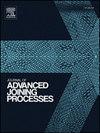Regulating intermetallic compound growth and bridging in SnAg solder under electromigration stress through Ni addition and sn crystallographic orientation-grain size
IF 4
Q2 MATERIALS SCIENCE, MULTIDISCIPLINARY
引用次数: 0
Abstract
As semiconductor devices scale down, electromigration (EM) failures in interconnects become more severe, requiring effective under-bump metallization (UBM) strategies. Herein, we investigated EM failures correlated with the development of intermetallic compounds (IMCs) in two UBM structures (Cu/SnAg/Cu and Cu/SnAg/Ni/Cu). Results showed that the Ni layer resulted in thinner IMCs. It acted as a diffusion barrier, which effectively suppressed IMC growth. We also found that the IMC formation in both solder structures was significantly influenced by the Sn grain orientation. A lower c-axis angle of beta-Sn to EM flow associated with faster IMC formation. Sn grain size also impacted IMC growth, with larger grains resulting in slower IMC formation as a result of the reduced grain boundary density. In addition, the IMC bridging phenomenon was observed in the joints. It was found that IMC bridging occurred less frequently in Ni UBM solder joints compared to Cu/SnAg/Cu counterparts. Such a difference could be attributed to the lower solubility of Ni in Sn compared to Cu. The Ni served as a barrier, which limited the Ni dissolution into the Sn solder. It suppressed the IMC formation/growth, thereby reducing the IMC bridging probability in the Cu/SnAg/Ni/Cu joints.
通过添加Ni和sn晶粒取向调节电迁移应力下SnAg焊料中金属间化合物的生长和桥接
随着半导体器件的小型化,互连中的电迁移(EM)故障变得更加严重,需要有效的碰撞下金属化(UBM)策略。在此,我们研究了两种UBM结构(Cu/SnAg/Cu和Cu/SnAg/Ni/Cu)中与金属间化合物(IMCs)发展相关的EM失效。结果表明,Ni层导致imc变薄。它起到了扩散屏障的作用,有效地抑制了IMC的生长。我们还发现,两种焊料结构的IMC形成都受到Sn晶粒取向的显著影响。β - sn - EM流的c轴角越小,IMC形成越快。Sn晶粒尺寸也会影响IMC的生长,晶粒越大,由于晶界密度降低,导致IMC形成较慢。此外,在关节中观察到IMC桥接现象。与Cu/SnAg/Cu焊点相比,IMC桥接在Ni UBM焊点中发生的频率更低。这种差异可能是由于Ni在Sn中的溶解度比Cu低。镍作为阻挡层,限制了镍在锡焊料中的溶解。它抑制了IMC的形成/生长,从而降低了Cu/SnAg/Ni/Cu接头中IMC的桥接概率。
本文章由计算机程序翻译,如有差异,请以英文原文为准。
求助全文
约1分钟内获得全文
求助全文

 求助内容:
求助内容: 应助结果提醒方式:
应助结果提醒方式:


